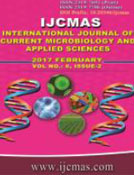


 National Academy of Agricultural Sciences (NAAS)
National Academy of Agricultural Sciences (NAAS)

|
PRINT ISSN : 2319-7692
Online ISSN : 2319-7706 Issues : 12 per year Publisher : Excellent Publishers Email : editorijcmas@gmail.com / submit@ijcmas.com Editor-in-chief: Dr.M.Prakash Index Copernicus ICV 2018: 95.39 NAAS RATING 2020: 5.38 |
A field experiment was conducted at Student Instructional Farm, C.S. Azad University of Agriculture and Technology, Kanpur with three dates of sowing viz. November, 03, 10 and November, 17, 2011 and used three varieties of mustard viz. Vaibhav, Vardan and Varuna with four replication under Split Plot Design. Among various micrometeorological characters of mustard higher growing degree days/heat unit and Helio-thermal units were found in November 03 sowing where sowing mean temperature was 22.9 0C.Heat unit in terms of biological yield (kg/ha) was higher in the crop sown on November 03. The L. erysimi peak population was found on 7th week at 17th Nov. date of sowing. 3rd (17th November) date of sowing when mean temperature 18.7 0C and relative humidity percentage was 71.0% favourable to highest aphid population, when the mean weekly temperature was 29.10C and relative humidity 55% (10th MW), sharp declining were seen in aphid population after 10th mean week weather attributed to rising temperature and sunshine hours coupled with crop maturity.
 |
 |
 |
 |
 |